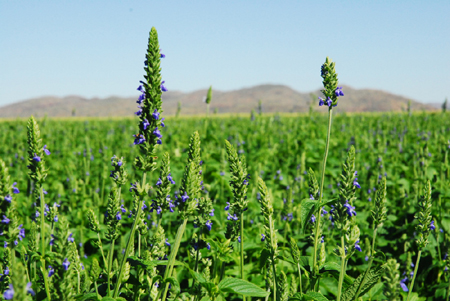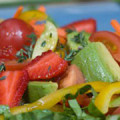
After taking several hours to read up on Salvia hispanica L. I am astonished that it hasn’t already officially replaced flax as the “Newest and Coolest Staple Seed”. But no doubt it will if the research and anecdotal evidence continues to pour in the way it is presently. That being said be forewarned that although small, this stuff packs a big punch and could even bring about harmful side effects.

Where does it come from?
Native to Mexico and Central America, chia seeds have been a go-to source of nutrient dense food for centuries among the Aztecs. They believed it had medicinal qualities and was a worthy offering to their gods and persons of nobility but it was also used as a (virtually weightless) source of sustained energy during times of battle and hunting. They were eaten as a grain alone or mixed with other grains , drank as a beverage when placed in water, ground into flour and pressed for oil to used as base for face and body paint.
Nutritional make-up
Chia seeds are high in protein, fiber, calcium, magnesium and Omega-3 fatty acids (the most of any plant source currently known). One ounce contains about 140 calories, 4 grams of protein and 11 grams of fiber (42% of the daily recommendation). They also contain natural anti-oxidants and the essential minerals phosphorus, manganese, potassium and sodium.
What are the potential benefits?
Weight Loss/Control Aid: Chia seeds can be easily and quickly made into and used as a fat replacement in baked goods. Also, the high fiber content might leave individuals feeling fuller longer.
Endurance: Because of its high caloric content and slow absorption into the system, chia seeds might serve as a good food to take before a training session or perhaps on a hike, day of skiing, etc.
Lower Blood Pressure: This where the idea of it having medicinal qualities comes into the picture. For individuals who suffer from hypertension this might be good news but the opposite is true if you’re a person who has abnormally low pressure. In this case moderate intake of chia seeds is advised along with consulting your doctor.
Diabetes: In 2007 Diabetes Care Journal published a study looking at the effects of chia seed on 20 males with Type 2 Diabetes. While undergoing the chia diet there was a significant reduction in C-reactive protein (an inflammatory marker), improvements in blood sugar control (A1C) and circulatory factors (fibrinogen) and a drop in systolic blood pressure.
Ongoing Research: Chia seeds are currently being studied for how they might benefit post-menopausal women. (see references below for link)
How do they compare to flax seed?
The nutrient breakdown and taste (mild nutty flavor) of chia and flax is comparable but what sets it apart is how easy it is to digest. With flax grinding it is a must due to its hard shell but chia seed easily breaks down whether whole or ground. Chia seed does not need to be stored in a special container in the fridge of freezer and can be stored for years without deterioration of flavor, odor or nutritional value.
Here’s a detailed look at the composition comparison: http://www.azchia.com/research/flax.htm
Additions and Replacements
Thanks to www.chiarecipes.com, here’s a modified list (for Vegans) for how to incorporate chia into your daily routine.
- Mix 2 tsp. with ¼ cup of water to make an egg substitute (otherwise known as “Chia Gel”) for baking cakes.
- Add chia seeds to apple juice to make “Sago”
- Grind seeds and add to hot mylk to make porridge.
- Add seeds to soup to thicken.
- Add seeds to salad dressings in place of poppy seeds.
- Eat whole and raw as a snack.
- Blend into smoothies.
- Add ground seeds to flour when making bread.
- Stir whole seeds through cooked lentils.
- Cook brown rice in vegetable stock and stir in chia seeds when rice is cooked.
- Cook brown rice in apple juice, add grated apple and stir in whole seeds through the mixture for tasty dessert.
- Mix ground seeds with peanut or other nut butter for a nutritious spread.
- Make a pasta sauce by blending chia seeds, cooked cauliflower and vegetable stock.
- Add a couple teaspoons to coconut water(this is a good sports drink)
Known allergic reactions and Chia “Poot”
Unless you’re a person who’s susceptible to allergic reactions to seeds similar to that of chia, then you very likely won’t have a problem but if the following symptoms start showing up then stop eating them and consult a doctor: skin rashes, nausea, swelling of the mouth, diarrhea, breathing difficulty and anaphylactic shock.
A more likely side culprit might be some harmless but altogether socially unpleasant side effects. Yes, I’m talking about bloating and gas. You might recall that chia seeds have a large amount of fiber in them. When the fiber is broken down by bacteria in the large intestine the result might be the production of gas and taking a large amount of chia seeds day in and day out is what will contribute to bloating but this doesn’t happen to everybody. Introduce chia seeds into your diet slowly. Start with a teaspoon or two per day then work up from there.
Would you know a bad seed if saw it?
Chia seeds come in two different colors, black and white. There is little difference between the two from a nutrient standpoint but the white ones tend to be more expensive because they’re grown in smaller quantities.
When looking for a good quality chia seed, avoid the ones that are brown in color. This indicates an immature seed that has substantially less protein, oil and Omega-3 fatty acids. Bulk chia seeds should appear clean, whole, shiny, oval-shaped and free of weed seeds and other plant parts.
Modern science serves as an important tool to better understand the world of nutrition and yet how fascinating it is to see that what the Aztecs discovered thousands of years ago about the health properties of chia seed is no less true for us today. The next time you go to stock up on flax seed, try chia as an alternative.
by Melissa Sanborn of Nutritional Brands, PureVegan
References
- Side Effects of Chia Seeds. www.chia-side-effects.info/side-effects/
- Composition of flax and chia seeds (per 100 gram edible portion). http://www.azchia.com/research/flax.htm
- Supplementation of Conventional Therapy with the Novel Grain Salba(Salvia hispanica L.) Improves Major and Emerging Cardiovascular Risk Factors in Type 2 Diabetes. Diabetes Care Journal November 2007, vol. 30 no. 11 2804-2810. www.care.diabetesjournals.org
- New Study Explores Health Benefits of Chia seeds. www.IndependentTribune.com February 29th, 2012.
- Chia History-An Ancient Crop Dr. Wayne Coates, http://www.azchia.com/chia_seed_history.htm
- 40 Ways to Use Chia Seeds http://www.chiaseedrecipes.com/40-ways-to-use-chia-seeds.php





1 Comment
Chia (324 comments)
March 9, 2012 at 8:20 amWe have some chia seeds at home; my husbands soaks them and use in a cereal.
I have also a jar of hazelnut butter with cacao butter and chia seed oil, and it’s delicious.